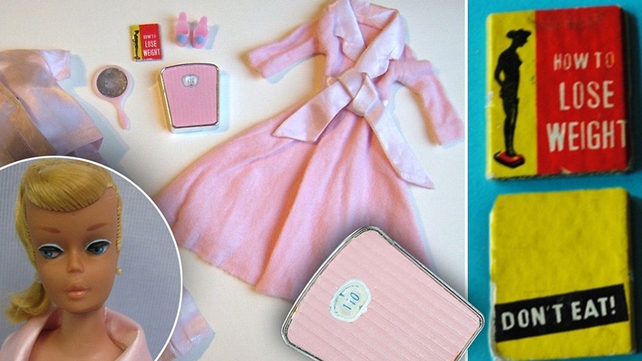Yesterday I collected my toddler son from crèche. Not having any daughters, I’m not that familiar with little girls’ toys anymore, so I was surprised when I picked up a Barbie doll that had been discarded on the crèche floor and noticed that she was exactly the same as she had been when I was a little girl: tall, blonde, skinny, busty. And wearing pink, of course.
I commented to one of the crèche staff that not much had changed in Barbie world and asked them if they had ever seen pictures on the internet of the women who have transformed themselves into ‘human Barbies’. Have a look. It’s one of the more frightening sides of body dysmorphia you’re likely to see. In the 1960s, Slumber Party Barbie was ready for her sleepover with the girls and had her bag packed with hair rollers, a sleeping bag, hair brush... a weighing scales and a little book entitled How to Lose Weight.

There’s no denying that Barbie has always put forward a very unrealistic and analogous idea of what a woman should be. And that’s not even getting into the issue of Barbie’s well-documented issues with ethnicity and the talking Barbie 'math class is tough’ debacle (see below).
But there is another side to Barbie. She went to the moon in 1965 - four years before Neil Armstrong. In the '70s she had stints as a surgeon and an Olympic athlete. In the 1980s Day-to-Night Barbie had it all: she could work nine-to-five and then change in a second for an evening with Ken. In 1992, 2004, 2008 and 2012, Barbie ran for President of the United States.
Barbie biographer M.G. Lord, says in her 2004 book Forever Barbie: The Unauthorized Biography of a Real Doll: "To first-generation Barbie owners, of which I was one, Barbie was a revelation. She didn't teach us to nurture, like our clinging, dependent Betsy Wetsys and Chatty Cathys. She taught us independence. Barbie was her own woman. She could invent herself with a costume change: sing a solo in the spotlight one minute, pilot a starship the next. She was Grace Slick and Sally Ride, Marie Osmond and Marie Curie.
"She was all that we could be and - if you calculate what, at human scale, would translate to a thirty-nine-inch bust - more than we could be."
Barbie is an anomaly. Since 1959 she has been proving to young girls all over the world that women can be whatever they want to be, whether that’s the owner of a poodle-grooming salon, a UN ambassador, an aerobics instructor or a soldier in the US Army. But her perfect hair, big breasts, ivory skin and skyscraper legs have also underpinned the message that, whatever you do, it’s of the utmost importance that you look stereotypically attractive and feminine whilst doing it.
A long-time world leader in toy sales, Mattel was bumped off the top-slot in 2014 by the makers of the construction blocks traditionally marketed as a ‘boy’s toy’, Lego. This success was in part due to the release of The Lego Movie, but also due to the crazy fact that girls like Lego too – and not just ‘girl Lego’. Mattel is (eventually) coming around to the realisation that parents want their children to play with toys that instil confidence in their children and encourage them to eschew traditional stereotypes related to gender and body image.
Barbie is smart. Barbie knows that all little girls won’t all grow up to look like her. She also knows that those little girls of all shapes and sizes will grow up to be women of all shapes and sizes who will in turn want their own sons and daughters to have a realistic expectation of what women can do (everything) and what they can look like (anything). And maybe President Barbie 2016 can be a brunette size 14.


